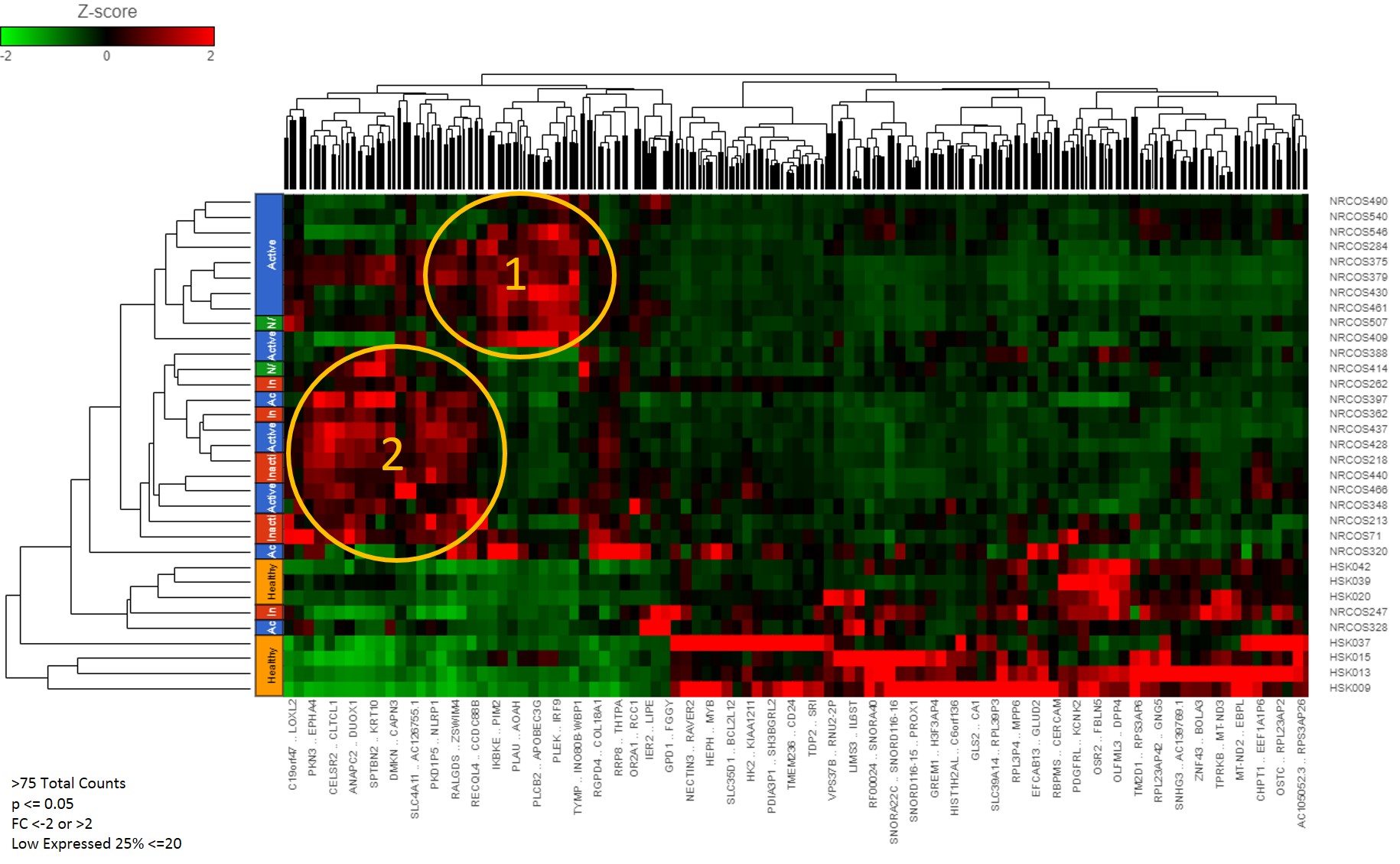Session Information
The 2020 Pediatric Rheumatology Symposium, originally scheduled for April 29 – May 2, was postponed due to COVID-19; therefore, abstracts were not presented as scheduled.
Session Type: Poster Breakout Session
Session Time: 5:10PM-5:40PM
Background/Purpose: Juvenile localized scleroderma (jLS) is an autoimmune disease of the skin and underlying tissue that is characterized by an earlier inflammatory infiltrate, followed by fibrosis and collagen deposition, and eventual atrophy. The consequences of jLS include significant disfigurement and functional disability, especially if left unchecked. Our goal was to determine the transcriptome within inflammatory and fibrotic LS tissue vs. healthy controls to identify potential molecular targets using RNA sequencing (RNAseq). Differentially expressed genes (DEGs) identified in jLS patients were compared to histopathological features to determine correlation.
Methods: RNAseq was performed on paraffin-embedded skin (n=26 jLS, n=7 pediatric healthy) using the Illumina HTS and TrueSeq Access library preparation. Paired-end RNAseq data was aligned using STAR, corrected for batch effect and analyzed for DEGs using DESeq2. Genes were analyzed using DEG cutoffs of log fold change > ±2.0, adjusted p< 0.05, and a false discovery rate (FDR) cutoff of < 0.05 for Reactome and enrichment software (GSEA©). Skin biopsies were reviewed by 2 blinded pathologists who determined 3 areas of inflammatory infiltrate per skin layer (papillary dermis, upper and lower reticular dermis) and counted total inflammatory cells (lymphocytes and plasma cells) per infiltrate, which determined both a categorical and numerical inflammatory score. Similar scoring was also developed for fibrosis, where 3 areas were chosen per skin layer and 3 measurements of collagen bundle thickness were taken. The average of these measurements was used for fibrotic scoring. Spearman’s correlation was used to determine significance between genes of interest and histology scoring.
Results: We found 804 significant DEGs with analysis between jLS vs. pediatric healthy controls with the above cutoffs. On hierarchical clustering using complete linkage of Euclidean distance, demonstrated two distinct jLS groupings (Figure 1). In Group 1 72 DEGs were identified, which associate with interferon gamma signaling, MHC class II antigen presentation, and TCR signaling (p< 0.01). Specifically, five are HLA class II genes, HLA-DQA1, HLA-DQB1, HLA-DRB5, HLA-DPB1, and HLA-DRB1 (p< 0.01, FC >2, FDR< 0.05). Degree of inflammatory cell infiltrate of the skin significantly correlated with HLA-DPB1, HLA-DQA2, HLA-DRA, and STAT1 (rs > 0.5, p< 0.01). Collagen thickness in upper reticular dermis had a positive correlation with HLA-DQA1 (rs=0.46, p=0.03). In Group 2, 151 DEGs were identified, which associate with pathways of FGFR1 amplification, collagen formation and keratinization (p< 0.05).
Conclusion: The identified groupings of jLS patients showed two distinct genetic signatures, with one having inflammatory related pathways upregulated, whereas the second group have fibrosis related pathways upregulated. Within the inflammatory group HLA Class II gene upregulation was demonstrated, which has also been described in literature for systemic sclerosis. Further investigation into the relationship and functions of these genes in jLS tissue is underway and will aid in understanding of jLS pathophysiology and potentially advancing treatment options for jLS patients.
To cite this abstract in AMA style:
Schutt C, Mirizio E, Schollaert-Fitch K, Torok K. HLA Genetic Signatures Associated with Inflammatory Sub-type in Juvenile Localized Scleroderma [abstract]. Arthritis Rheumatol. 2020; 72 (suppl 4). https://acrabstracts.org/abstract/hla-genetic-signatures-associated-with-inflammatory-sub-type-in-juvenile-localized-scleroderma/. Accessed .« Back to 2020 Pediatric Rheumatology Symposium
ACR Meeting Abstracts - https://acrabstracts.org/abstract/hla-genetic-signatures-associated-with-inflammatory-sub-type-in-juvenile-localized-scleroderma/

